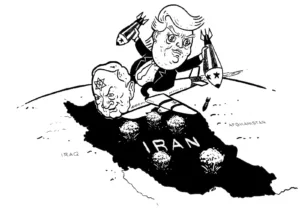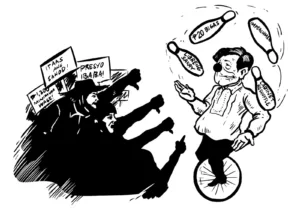Communist Party of the Philippines
Gloria Macapagal-Arroyo’s “It’s the economy, student” is a shameless paper of self-promotion built on lies and half-truths — the very same foundation on which, for nine long years, she built her corrupt and brutal regime from 2001 to 2010. It presents itself as a professor’s critique of her student’s economic policies, but is actually nothing more than a shallow political diatribe.
Arroyo tries to differentiate herself from Aquino in form, portraying herself as the “hardworking professor” and Aquino as “the easy go lucky student”. However, she failed to point out any crucial difference in terms of content, because in reality, there is none.
Aquino, like his teacher Arroyo, upholds the basic economic policies instigated by US imperialism and pushed by the International Monetary Fund and World Bank. Arroyo is no original. And neither is her student Aquino. They both are disciples of neoliberal economic policies and defenders of the Philippine semicolonial and semifeudal system. They both are advocates of trade and investment liberalization, deregulation, denationalization and privatization, which have resulted in economic stagnation and the people’s deteriorating socio-economic conditions.
In terms of economic policy, Arroyo and Aquino, the teacher and the student, are so much the same. Let us count the ways:
Arroyo and Aquino are defenders of the Expanded Value Added Tax. Arroyo considered it her ‘centerpiece’ fiscal measure. In full agreement with his teacher, Aquino refuses to remove the EVAT imposed on oil prices and has imposed it on toll fees. In the face of the continued slowdown in domestic production and economic activity, for both Arroyo and Aquino, the EVAT, which taxes the ordinary people is the easiest way to generate government revenue.
Neither Aquino nor Arroyo conforms to the idea of increasing workers’ wages substantially to allow them to cope with rising costs of living. During the nine-year Arroyo regime, daily minimum wages in the national capital region were on the average increased by a mere P17 (Philippine Pesos). Last year, under Aquino, daily minimum wages were increased by only P22. Both Aquino and Arroyo oppose the clamor to raise daily minimum wages by P125.
As senator, Gloria Arroyo was one of the proponents of the Oil Deregulation Law when it was deliberated on and eventually enacted in 1998. For nine years under her term as president, she allowed foreign oil monopoly companies to jack up oil prices with impunity, reaching unprecendented levels at around 2008. Her student Aquino is in complete agreement. Despite growing clamor, he has refused to even hear petitions to repeal the oil deregulation law. He has also refused to heed the demand for the removal of the 12% EVAT imposed on petroleum products.
Arroyo was the principal proponent of the Mining Act of 1995. Like his teacher, Aquino has campaigned to attract foreign mining companies, conforming to the misguided notion that mining will bring development and employment. Neither Arroyo nor Aquino considers the fact that mining contributes a mere 0.6% to total employment in the Philippines. This minuscule input comes at an enormous cost to the Filipino people who suffer the irreversible loss of their natural resources.
Arroyo was also the principal proponent of the Electric Power Industry Reform Act (EPIRA) which deregulated the power industry. Despite the glaring fact that the EPIRA has failed to bring down electricity rates as it promised, Aquino does not intend to have the law reviewed or repealed, knowing full well that he counts among his campaign supporters the Lopezes who hold vast interests in the power industry.
Aquino, like his teacher Arroyo, does not have a program for national industrialization to spur domestic economic production and generate employment. Lacking such, the only recourse of the Arroyo regime was to offer foreign big capitalists cheap Filipino call center agents for business process outsourcing and intensify the deployment of overseas contract workers. Aquino’s employment thrust is no different. He will, however, have to contend with the contraction of international labor markets and the current drive in the US to reverse outsourcing and bring the jobs back to the US. In any case, both Aquino and Arroyo’s economic policy fail to provide a strategic blueprint to resolve the chronic and acute problem of unemployment that beset the Philippines.
Arroyo, like Aquino, is opposed to genuine land reform. In November 2004, when the Aquino and Arroyo families were still friends, Arroyo ordered the deployment of the military to suppress the Hacienda Luisita strike which resulted in the massacre of seven farm workers. Similarly, peasant leaders in the Arroyo lands in Negros were suppressed as they clamored for the free distribution of land.
Both Arroyo and Aquino are masters of statistical manipulation in covering up the grave socio-economic problems of the poeple. In 2005, Arroyo was able to reduce the number of unemployed without actually creating jobs simply by redefining employment and who constitutes the labor force. In similar fashion, Aquino was able to bring down last year the number of people living below the food threshold by reducing the daily food basket (removing milk, for instance, from the morning meals of children).
Following his teacher’s footsteps, Aquino has continued and expanded the Conditional Cash Transfer Program funded by World Bank loans. Both Arroyo and Aquino speak of the CCT as an “anti-poverty” undertaking, in an attempt to make the people believe that their conditions will improve through small cash infusions even as the conditions for exploitation, oppression and poverty persist.
Aquino, as did Arroyo, pushes for the privatization or increasing role of private business in providing education, health and other services. Aquino, like Arroyo, has cut back on social spending, making education, health and other services increasingly inaccessible to the people.
Like his predecessor Arroyo, Aquino gives little damn about the social wellbeing of the people. Neither regime addressed the demand of the urban poor dwellers for on-site development or in-city relocation, stubbornly insisting on dumping them in areas far from their places of employment and with little opportunity to make a living.
Even as both Aquino and Arroyo are prone to profligate spending—Arroyo has Le Cirqué while Aquino has his Porsché, the student learned from his teacher that as president, it is better to keep one’s hand clean, and just let your men do the dirty work. The appearance of clean governance allows bureaucrat capitalism to thrive under Aquino as during the Arroyo regime. State privilege and power continue to be employed for the benefit of big business interests, specifically of those who are supportive of or affiliated with the ruling clique.
Finding a fundamental difference between Arroyo and her economics student Aquino is an exercise in futility. Arroyo’s policies then, are Aquino’s policies now. For that matter, their policies are essentially the same as those of previous regimes since the inception of the neocolonial state in 1946.
These are policies that oppose land reform and prevent national industrialization, progress and economic modernization. These are policies that perpetuate the semicolonial and semifeudal system and subject the people to perpetual exploitation, oppression and poverty.
Precisely because of the continuation of economic policies of the past, the Aquino regime is increasingly becoming isolated from the Filipino people. The Filipino people are increasingly disgusted over the deteriorating conditions under the Aquino regime and are bound to rise up in their millions against the neoliberal policies of US imperialism and its puppet regime.










